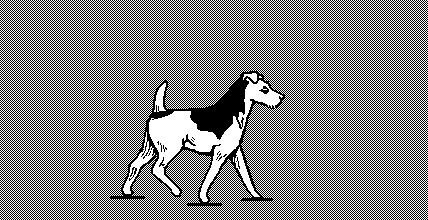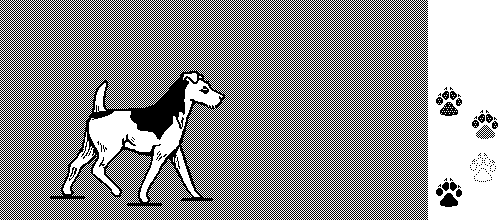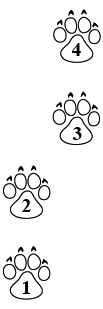A normal
walk is shown in the above cartoon. The walk step sequence is shown to the right. The walk is the least-tiring gait. It is a four-beat gait, in which each limb steps (lift/swing/support/thrust) sequentially. Several types of "walk" are recognized, based on variations in limb support, stride length, and step speed:
In the
normal walk, two limbs alternate with three limbs in supporting body weight. Thus, eight different combinations of limb support occur during one stride: four combinations of three-leg support interspersed with four combinations of alternating two-leg support (right/left diagonal & right/left lateral support). For each limb, the duration of support exceeds that of swing.
The neck and head are lowered during forelimb swing and raised during forelimb support phases. The trunk undulates laterally as well as vertically, and the tail and head swing toward the side being laterally supported. Stride length is such that the hind paw approximately overlays the site occupied by the ipsilateral fore paw. If the dog is slow to lift its fore paw when placing its hind paw, interference can result (forcing the dog to side-step).
The
power walk (see
Power Walk) is used when pulling a load. Steps are shorter and slower and three-leg support predominates. Thus the phases of two-leg support are absent (or very brief) and lateral oscillation of the head and tail is unnecessary. The head may be lowered to shift the center of gravity forward, counteracting a load effect. The fore limbs contribute significantly to propulsion (vs. just hind limbs in the other walk gaits)
In the
quick walk (see
Amble), swing and support phases of a step are equivalent in duration. No more than two limbs simultaneously support body weight (diagonal support alternates with lateral support). The hind paw impacts in front of the impact site of the fore paw. The quick walk is also known as "
running walk", "
slow amble", & "
long-striding walk". The Tennessee Walking Horse specializes in a quick walk (amble).
Other variations of the walk are seen in trained animals (e.g., dressage horses and Hackney ponies), in exhausted animals, and in animals with conformation deficiencies.





